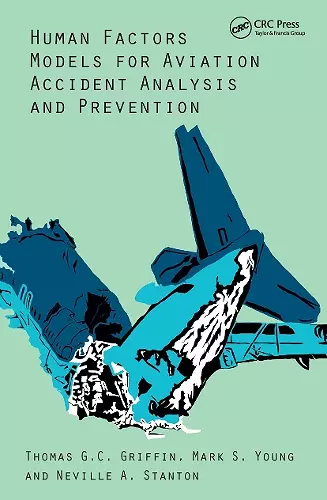Human Factors Models for Aviation Accident Analysis and Prevention
Mark S Young author Neville A Stanton author Thomas GC Griffin author
Format:Hardback
Publisher:Taylor & Francis Ltd
Published:28th Feb '15
Currently unavailable, and unfortunately no date known when it will be back

The investigation and modelling of aviation accident causation is dominated by linear models. Aviation is, however, a complex system and as such suffers from being artificially manipulated into non-complex models and methods. This book addresses this issue by developing a new approach to investigating aviation accident causation through information networks. These networks centralise communication and the flow of information as key indicators of a system’s health and risk. This holistic approach focuses on the system environment, the activity that takes place within it, the strategies used to conduct this activity, the way in which the constituent parts of the system (both human and non-human) interact and the behaviour required. Each stage of this book identifies and expands upon the potential of the information network approach, maintaining firm focus on the overall health of a system. The book’s new model offers many potential developments and some key areas are studied in this research. Through the centralisation of barriers and information nodes the method can be applied to almost any situation. The application of Bayesian mathematics to historical data populations provides scope for studying error migration and barrier manipulation. The book also provides application of these predictions to a flight simulator study for the purposes of validation. Beyond this it also discusses the applicability of the approach to industry. Through working with a legacy airline the methods discussed are used as the basis for a new and prospective safety management system.
"This is a challenging and promising book, breaking away from traditional perspectives that have dominated the academic debate for about 30 years, in particular with respect to human performance, decision making, and communication on a team level."
—John Stoop, Lund University, Sweden, from Newsletter of the Europe Chapter of the Human Factors and Ergonomics Society, No. 2, 2015
"Although the aviation industry has made tremendous progress during the last three decades by considerably reducing the number of fatal accidents, risk investigation models are still linear and new approaches, such as network-based models, must be developed. The information network approach provided in this book is crucial to better understand, analyze, design and evaluate current complexity of aviation human-system integration."
—Guy A. Boy, Florida Institute of Technology, USA; NASA Kennedy Space Center, USA; and Fellow of the Air and Space Academy
"The authors undertake a comprehensive and systematic analysis of a range of approaches to error causation, and have extended this analysis into systemic accident and incident causation. They both advocate and demonstrate important new methodologies that can be used to draw meaning from complex occurrences, thereby enabling the identification and implementation of meaningful interventions. Finally, they tackle the issue of the validity of post-hoc analyses of accidents and incidents and how models of causation might be examined empirically. It is a text that casts an eye both to the past and to the future of modelling and the prediction of complex events."
—Mark Wiggins, Macquarie University, Australia
"... provides a new and very promising approach to understanding the complex, systemic, and non-linear causes of accidents in both commercial and general aviation. It represents a very important contribution to the field of aviation accident investigation, and one that should be read by both researchers and practitioners in that field."
—Steven J. Landry, Purdue University, USA
"This book argues for the systems-thinking approach to accident and incident investigation. As such it is very much ‘on message’: bodies like the International Civil Aviation Organization (ICAO), the European Aviation Safety Agency (EASA) and the UK’s Civil Aviation Authority (CAA) all recommend the holistic, systems-thinking-informed approach to investigation.
Based on original research conducted both in the laboratory and in the field, the authors offer a novel systems-analysis tool based on Bayesian precepts. Specifically, the tool attaches probabilistic risk assessments to pilots’ decisions/actions. The tool can be applied retrospectively and prospectively.
As, thankfully, disasters become less frequent, the authors make an eloquent case for incident-centrism in risk-assessment: "Incidents work well to populate the information networks, and key to their use is to identify the potential outcomes, and the reasons for a more positive outcome than an accident" (p 201). Viewing incidents through Prof Brian Toft’s Active Learning prism will save lives."
—Simon A Bennett, Director, Civil Safety and Security Unit (CSSU), University of Leicester, UK
ISBN: 9781472432759
Dimensions: unknown
Weight: 544g
226 pages